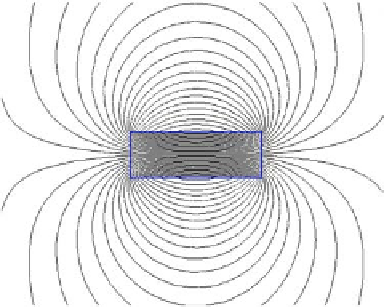Hardware Reference
In-Depth Information
Figure 4.1: Flux lines generated by a permanent magnet
4.1.2 Flux Density (Magnetic Induction)
Flux density is a vector, and is normally denoted by the symbol B. It describes
the magnetic
fi
elddistributioninthespaceandgives
fl
ux lines through a unit
area. The SI unit of the
fl
ux density is Tes la (T),orWeber per square
meter (Weber/m
2
). In the electrical engineering, Gauss is also used as the
unit of
fl
ux density where 1 Gauss = 10
−4
Tes l a .
The relationship between the
fl
ux density and the
fl
ux can be described by
Z
B.dS.
Φ =
(4.1)
S
B is the
In the equation, S is the area where the
fl
ux lines going through, and
fl
ux density at the local area d S.
In the electric machine analysis, the
fl
ux density is very import in analyzing
the local
fi
eld effects, e.g., the magnetic saturation at a point, and the leakage
fi
eld in a local area.
4.1.3 Magnetic Field Strength, Permeability and Rela-
tive Permeability
Magnetic
fi
eld strength is a vector, and is normally denoted by the symbol
H. It describes the intensity of magnetic
fi
eld. The SI unit of magnetic
fi
eld
strength is Ampere per meter (A/m). Oersted (Oe) is also used in engi-
neering as an alternative unit, and 1Oe = 10
3
/4π A/m.
Flux density and magnetic
fi
led strength are closely related. In vacuum, B
is proportional to H,
B = µ
0
H
(4.2)

